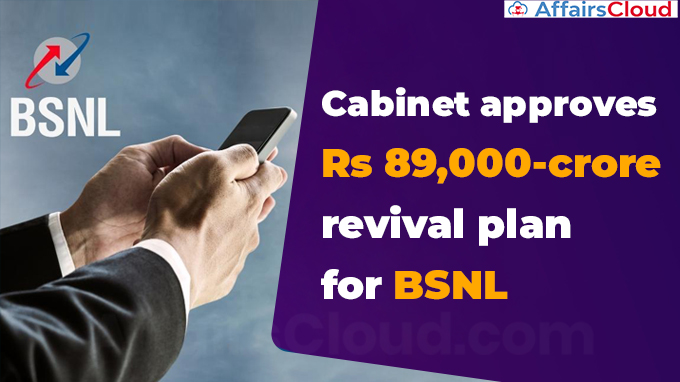 On June 07, 2023, the Union Cabinet chaired by the Prime Minister (PM) Narendra Modi approved the following proposals.
On June 07, 2023, the Union Cabinet chaired by the Prime Minister (PM) Narendra Modi approved the following proposals.
- Approved the third revival package for Bharat Sanchar Nigam Ltd (BSNL)
- Approved the increase in the Minimum Support Prices (MSP) for all mandated Kharif Crops
- Approved the continuation of the ‘Exploration of Coal and Lignite scheme’
- Approved Metro Connectivity from HUDA City Centre to Cyber City in Gurugram
Third revival package for BSNL:
i.The cabinet has approved the third revival package for Bharat Sanchar Nigam Ltd (BSNL) with a total outlay of Rs 89,047.82 crore that includes allotment of 4G/5G spectrum through equity infusion.
ii.The authorized capital of BSNL was increased from Rs 1,50,000 crore to Rs. 2,10,000 crore.
iii.With the third revival package, BSNL will emerge as a stable telecom service provider focused on providing connectivity to remotest parts of India.
The details of Budget and Specturm allotment :
| Band | Spectrum allotted | Budgetary support |
|---|---|---|
| 700 MHz | 10 MHz paired in 22 licensed service areas (LSAs) | Rs 46,338.60 Crore
|
| 3300 MHz | 70 MHz in 22 LSAs | Rs 26,184.20 Crore |
| 26 GHz | 800 MHz in 21 LSAs and 650 MHz in 1 LSA | Rs 6,564.93 Crore |
| 2500 MHz | 20 MHz in 6 LSAs and 10 MHz in 2 LSAs | Rs 9,428.20 Crore |
| Miscellaneous items | Rs 531.89 Crore | |
| Total | Rs 89,047.82 Crore | |
Key Points:
i.With the above budget allotment, BSNL could provide pan-India 4G and 5G services, provide 4G coverage in rural and uncovered villages under various connectivity projects, fixed wireless access (FWA) services for high-speed Internet, and services/ spectrum for captive non-public network (CNPN).
ii.Union Government had approved the first revival package for BSNL/Mahanagar Telephone Nigam Limited ( MTNL) in 2019 amounted to Rs. 69,000 Crore. In 2022, Government approved second revival package for BSNL/MTNL amounting to Rs 1.64 Lakh Crore.
- Due to these two packages, BSNL has started earning operating profits since FY 2021-22. Total debt of BSNL has reduced from Rs 32,944 Crore to Rs 22,289 Crore.
iii.It provided financial support for capex (Capital Expenditure), viability gap funding for rural landlines, financial support for de-stressing the balance sheet and settlement of adjusted gross revenue (AGR) dues and merger of BBNL with BSNL.
iv.As per the statement of Union Minister Ashwini Vaishnaw, Ministry of Communications and IT, BSNL was allocated Rs 53,000 crore capital in 2023 to construct new towers, enhance its 2G/3G, 4G and 5G networks pan India.
- BSNL also issued advanced purchase orders worth over Rs 19,000 crore to a consortium led by TCS and C-DOT for the deployment of 4G network.
Increase in MSP for Kharif crops
i.The Cabinet Committee on Economic Affairs (CCEA) chaired by PM Narendra Modi has approved the increase in the Minimum Support Prices (MSP) for all mandated Kharif Crops for Marketing Season 2023-24.
- Objective: To ensure remunerative prices to the growers for their produce and to encourage crop diversification.
- As per Third Advance Estimates for FY23, total Foodgrain production in India is estimated at a record 330.5 million tonnes which is higher by 14.9 million tonnes as compared to the FY22. This is the highest increase in the last 5 years.
ii.The MSP for Kharif Crops for Marketing Season 2023-24 was increased in line with the Union Budget 2018-19 announcement of fixing the MSP at a level of at least 1.5 times of the All-India weighted average Cost of Production, aiming at reasonably fair remuneration for the farmers. Click here to know the MSP for Kharif Crops
iii.The margin to farmers over their cost of production are estimated to be highest in case of bajra (82%) followed by tur (58%), soybean (52%) and urad (51%) and for rest of the crops it is estimated to be at least 50%.
iv.The Union Government launched schemes and initiatives, such as the Rashtriya Krishi Vikas Yojana (RKVY), the National Food Security Mission (NFSM), to encourage farmers to diversify their crops.
Continuation of ‘Exploration of Coal and Lignite scheme’
The CCEA chaired by PM Narendra Modi also approved the continuation of the central sector plan ‘Exploration of Coal and Lignite scheme’ with an estimated expenditure of Rs 2,980 crore with extension of time period from 2021-22 to 2025-26 co-terminus with the 15th Finance Commission cycle.
Key Points:
i.The exploration for coal and lignite under the scheme is conducted in two broad stages: (i) Promotional (Regional) Exploration and (ii) Detailed Exploration in non-Coal India Limited blocks.
ii.An outlay of Rs 1,650 crore will be provided for promotional (Regional) exploration and Rs 1,330 crore for detailed drilling in non-CIL (Coal India Limited) areas.
iii.Approximately 1,300 sq km area will be covered under Regional exploration, and about 650 sq km area will be covered under detailed exploration, it added.
iv.Purpose: The exploration for Coal and Lignite is required to prove and estimate the availability of coal resources in India, which would help further in preparing detailed project reports to start coal mining.
Metro Connectivity from HUDA City Centre to Cyber City
Union Cabinet headed by PM Narendra Modi also approved the extension of Metro Connectivity from HUDA City Centre on the Delhi Metro’s Yellow Line to Cyber City in Gurugram (Haryana) spanning a distance of 28.50 km and encompass a total of 27 stations along the route.
The entire project will be elevated and have a spur (side line) from Basai village to Dwarka Expressway, for connectivity to the depot.
- The total completion cost of the project will be Rs.5,452 crore. This will be a standard gauge line of 1435 mm (5 ft 8.5 inches).
- The project is proposed to be completed in 4 years from the date of sanction of the Project and it would be implemented by Harayana Mass Rapid Transport Corporation Limited (HMRTC) which will be set up as a 50:50 Special Purpose Vehicle (SPV) of the Government of India and Government of Haryana.
| Name of corridor | Length(in KM) | No. of Station |
|---|---|---|
| Huda City Centre to Cyber City – Main corridor | 26.65 | 26 |
| Basai Village to Dwarka Expressway – Spur | 1.85 | 01 |
| Total | 28.50 | 27 |
Benefit: The metro line will connect New Gurugram with Old Gurugram (which at present does not have any metro line). In next phase, it will provide connectivity to Indira Gandhi International Airport.
Existing metro lines in Gurugram:
i.Yellow Line: The Yellow Line which was introduced in June 2010, is operated by the Delhi Metro Rail Corporation (DMRC), stretches across 49.019 km and encompasses 37 stations, connecting Samaypur Badli to HUDA City Centre.
ii.Rapid Metro Gurugram – 2013: The Rapid Metro Gurugram, constructed in two phases, covers a route length of 11.6 km. The first phase, a 5.1 km loop from Sikandarpur to Cyber Hub, was initially built by a consortium involving DLF, IERS (IL&FS Enso Rail System), and ITNL (IL&FS Transport Network Limited).
- Since November 14, 2013, the first phase has been managed by Rapid Metro Gurgaon Ltd.
- The second phase, spanning 6.5 km from Sikandarpur to Sector-56, was constructed by a consortium consisting of ITNL and IRL (IL&FS Rail Limited) and has been operated by the Rapid Metro Gurgaon South Ltd since March 31, 2017.
Other Proposed Metro lines in Gurugram:
i.Gurgaon – Manesar – MBIR (82 km) line was proposed in 2015 and set to complete by 2017. However, the line has still not been developed.
ii.Gurgaon – Faridabad line had already been approved by the government and received the green light to begin development in March 2023 and the line will have 12 stops covering 34.12 km.
Recent Related News:
The Union Cabinet chaired by the Prime Minister (PM) Narendra Modi has approved the following proposals in February: Air Services Agreement between India and Guyana, Ratification of 3 Protocols on Article 3 bis and Article 50 (a) & Article 56 relating to amendments in the Chicago Convention, 1944, Extension of the term of the 22nd Law Commission of India upto 31st August, 2024, and Quality Control Order (QCO) for mandatory certification of cotton bales.




